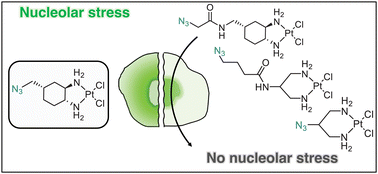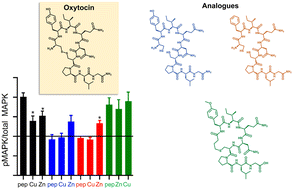Themed collection Chemical Biology of Metals

Introduction to “Chemical biology of metals”
Angela Casini (Technical University of Munich, Germany), Hui Chao (Sun Yat-Sen University, China), Hongzhe Sun (University of Hong Kong, China), and Christopher J. Chang (University of California, Berkeley, United States) introduce the themed collection on ‘Chemical biology of metals’.

RSC Chem. Biol., 2024, Advance Article
https://doi.org/10.1039/D4CB90017K
Copper binding and protein aggregation: a journey from the brain to the human lens
Metal ions are implicated in many proteinopathies. Three case studies are discussed to address how copper binding impacts protein folding and aggregation, and its relevance in understanding the polymorphic nature of the aggregates related to disease.

RSC Chem. Biol., 2023,4, 974-985
https://doi.org/10.1039/D3CB00145H
Unlocking the potential of platinum drugs: organelle-targeted small-molecule platinum complexes for improved anticancer performance
This review offers a concise overview of platinum-based anticancer complexes targeting various organelles, aiming to overcome the limitations of existing platinum drugs.

RSC Chem. Biol., 2023,4, 1003-1013
https://doi.org/10.1039/D3CB00087G
Transition metal ions and neurotransmitters: coordination chemistry and implications for neurodegeneration
This review describes how transition metal ions induce the conformational and functional changes of neurotransmitters.

RSC Chem. Biol., 2023,4, 548-563
https://doi.org/10.1039/D3CB00052D
Discovery of cisplatin-binding proteins by competitive cysteinome profiling
A competitive activity-based protein profiling strategy was developed to identify cisplatin-binding cysteines in MCF-7 proteomes, among which cisplatin-binding sites in GLRX1, TXNDC17 and MetAP1 were biochemically verified.

RSC Chem. Biol., 2023,4, 670-674
https://doi.org/10.1039/D3CB00042G
Mining proteomes for zinc finger persulfidation
A meta-analysis of 22 persulfide-specific proteomics datasets reveals widespread persulfidation of zinc finger proteins across various species, highlighting the role of persulfidation as an important post-translational modification.

RSC Chem. Biol., 2024, Advance Article
https://doi.org/10.1039/D3CB00106G
An AIE-based monofunctional Pt(II) complex for photodynamic therapy through synergism of necroptosis–ferroptosis
We report an AIE-based monofunctional Pt(

RSC Chem. Biol., 2024,5, 141-147
https://doi.org/10.1039/D3CB00113J
Reduction-cleavable desferrioxamine B pulldown system enriches Ni(II)-superoxide dismutase from a Streptomyces proteome
Two resins with the hydroxamic acid siderophore desferrioxamine B (DFOB) immobilised as a free ligand or its Fe(III) complex prepared to screen the Streptomyces pilosus proteome for proteins involved in siderophore-mediated Fe(III) uptake enriched for Ni(II)-superoxide dismutase on the apo-DFOB resin.

RSC Chem. Biol., 2023,4, 1064-1072
https://doi.org/10.1039/D3CB00097D
Comparison of click-capable oxaliplatin and cisplatin derivatives to better understand Pt(II)-induced nucleolar stress
A novel click-capable oxaliplatin mimic as a tool to study Pt(II)-induced nucleolar stress.

RSC Chem. Biol., 2023,4, 785-793
https://doi.org/10.1039/D3CB00055A
Dual-action gallium-flavonoid compounds for combating Pseudomonas aeruginosa infection
A gallium compound shows strong antibacterial effects against Pseudomonas aeruginosa while being low in cytotoxicity. It eradicates the pathogen by targeting quorum sensing and iron metabolism pathways, making it a “dual-action” antibacterial agent.

RSC Chem. Biol., 2023,4, 774-784
https://doi.org/10.1039/D3CB00033H
Siderocalin fusion proteins enable a new 86Y/90Y theranostic approach
The mammalian protein siderocalin binds hydroxypyridinone complexes of trivalent rare-earth metals and f-elements through cation-π and electrostatic interactions. It can also be fused with biological vectors for the targeted delivery of imaging and therapeutic radionuclides.

RSC Chem. Biol., 2023,4, 587-591
https://doi.org/10.1039/D3CB00050H
The effect of metalation on antimicrobial piscidins imbedded in normal and oxidized lipid bilayers
Structural changes due to metalation of the ATCUN motif of piscidins embedded in lipid bilayers are revealed through molecular dynamics simulations.

RSC Chem. Biol., 2023,4, 573-586
https://doi.org/10.1039/D3CB00035D
An anti-glioblastoma gold(I)–NHC complex distorts mitochondrial morphology and bioenergetics to induce tumor growth inhibition
A new gold(I)-based therapeutic strategy to treat glioblastoma multiforme (GBM).

RSC Chem. Biol., 2023,4, 592-599
https://doi.org/10.1039/D3CB00051F
Designed ankyrin repeat proteins for detecting prostate-specific antigen expression in vivo
Prostate specific antigen binding Designed Ankyrin Repeat Proteins (DARPins) were selected and C-terminally conjugated for Gallium-68 radiolabelling. Two of the developed tracers showed specific uptake in mouse prostate tumour models.

RSC Chem. Biol., 2023,4, 494-505
https://doi.org/10.1039/D3CB00010A
Radiolabeling and in vivo evaluation of lanmodulin with biomedically relevant lanthanide isotopes
This work describes successful radiochemical labeling and subsequent in vivo evaluation of radiolanthanide-tagged versions of lanmodulin (LanM), a lathanide-binding protein.

RSC Chem. Biol., 2023,4, 414-421
https://doi.org/10.1039/D3CB00020F
A monoadduct generating Ru(II) complex induces ribosome biogenesis stress and is a molecular mimic of phenanthriplatin
Phenanthriplatin forms DNA mono-adducts and induces ribosome biogenesis stress. Using a semi-rational strategy, Ru(II) complexes were created that act as biological mimics of phenanthriplatin with improved properties.

RSC Chem. Biol., 2023,4, 344-353
https://doi.org/10.1039/D2CB00247G
Investigation of metal modulation of oxytocin structure receptor-mediated signaling
Oxytocin and a library of analogs show metal-dependent modulation of MAPK activation in oxytocin-receptor-expressing HEK293 cells.

RSC Chem. Biol., 2023,4, 165-172
https://doi.org/10.1039/D2CB00225F
Dinuclear nitrido-bridged osmium complexes inhibit the mitochondrial calcium uniporter and protect cortical neurons against lethal oxygen–glucose deprivation
We have investigated the biological properties of the osmium analogue of a potent ruthenium-based mitochondrial calcium uniporter inhibitor and have found it to possess distinct properties.

RSC Chem. Biol., 2023,4, 84-93
https://doi.org/10.1039/D2CB00189F
About this collection
This themed collection, guest edited by Angela Casini (Technical University of Munich, Germany), Christopher J. Chang (University of California, Berkeley, United States), Hui Chao (Sun Yat-Sen University, China) and Hongzhe Sun (University of Hong Kong, China) offers articles showcasing the ongoing interest in the chemical biology of metals.
Recent years have witnessed significant advances in the development of new imaging probes that can probe the physiological and pathological roles of metals in biology and/or leverage unique properties of metal coordination chemistry and metal-based medicines. In addition, significant progress has been made in understanding metallomedicines and studying metal-based catalysis and signaling in living systems. We have collected contributions that are representative of the tremendous promise and pace of growth in this area.